warning light SKODA CITIGO 2012 1.G Repair Manual
[x] Cancel search | Manufacturer: SKODA, Model Year: 2012, Model line: CITIGO, Model: SKODA CITIGO 2012 1.GPages: 157, PDF Size: 3.9 MB
Page 117 of 157
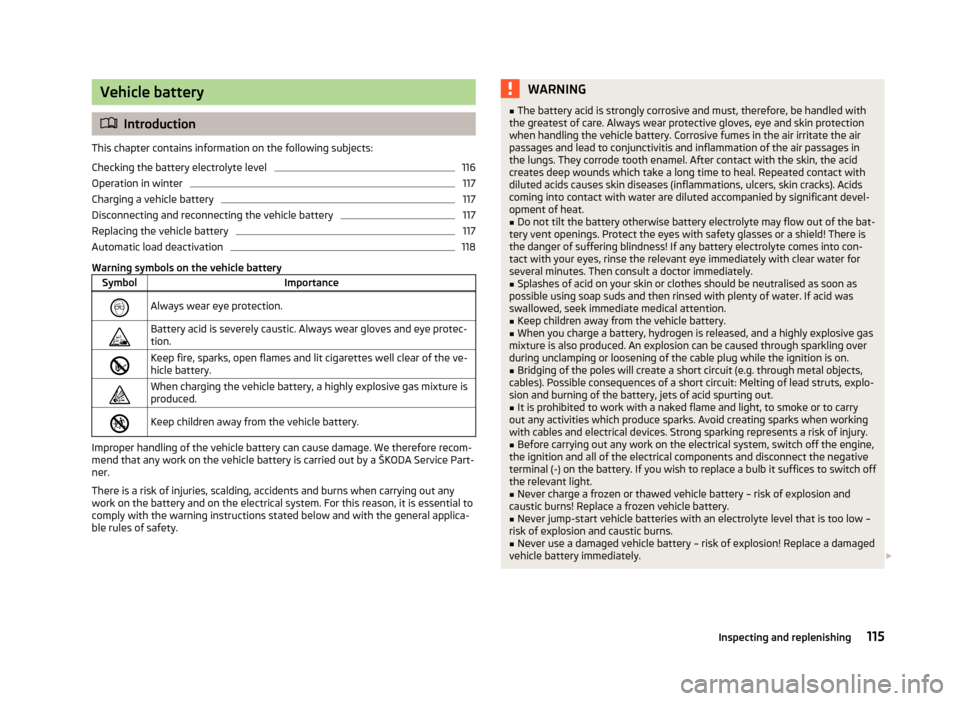
Vehicle battery
ä
Introduction
This chapter contains information on the following subjects:
Checking the battery electrolyte level 116
Operation in winter 117
Charging a vehicle battery 117
Disconnecting and reconnecting the vehicle battery 117
Replacing the vehicle battery 117
Automatic load deactivation 118
Warning symbols on the vehicle battery Symbol Importance
Always wear eye protection.
Battery acid is severely caustic. Always wear gloves and eye protec-
tion.
Keep fire, sparks, open flames and lit cigarettes well clear of the ve-
hicle battery.
When charging the vehicle battery, a highly explosive gas mixture is
produced.
Keep children away from the vehicle battery. Improper handling of the vehicle battery can cause damage. We therefore recom-
mend that any work on the vehicle battery is carried out by a
ŠKODA Service Part-
ner.
There is a risk of injuries, scalding, accidents and burns when carrying out any
work on the battery and on the electrical system. For this reason, it is essential to
comply with the warning instructions stated below and with the general applica-
ble rules of safety. WARNING
■ The battery acid is strongly corrosive and must, therefore, be handled with
the greatest of care. Always wear protective gloves, eye and skin protection
when handling the vehicle battery. Corrosive fumes in the air irritate the air
passages and lead to conjunctivitis and inflammation of the air passages in
the lungs. They corrode tooth enamel. After contact with the skin, the acid
creates deep wounds which take a long time to heal. Repeated contact with
diluted acids causes skin diseases (inflammations, ulcers, skin cracks). Acids
coming into contact with water are diluted accompanied by significant devel-
opment of heat.
■ Do not tilt the battery otherwise battery electrolyte may flow out of the bat-
tery vent openings. Protect the eyes with safety glasses or a shield! There is
the danger of suffering blindness! If any battery electrolyte comes into con-
tact with your eyes, rinse the relevant eye immediately with clear water for
several minutes. Then consult a doctor immediately.
■ Splashes of acid on your skin or clothes should be neutralised as soon as
possible using soap suds and then rinsed with plenty of water. If acid was
swallowed, seek immediate medical attention.
■ Keep children away from the vehicle battery.
■ When you charge a battery, hydrogen is released, and a highly explosive gas
mixture is also produced. An explosion can be caused through sparkling over
during unclamping or loosening of the cable plug while the ignition is on.
■ Bridging of the poles will create a short circuit (e.g. through metal objects,
cables). Possible consequences of a short circuit: Melting of lead struts, explo-
sion and burning of the battery, jets of acid spurting out.
■ It is prohibited to work with a naked flame and light, to smoke or to carry
out any activities which produce sparks. Avoid creating sparks when working
with cables and electrical devices. Strong sparking represents a risk of injury. ■ Before carrying out any work on the electrical system, switch off the engine,
the ignition and all of the electrical components and disconnect the negative
terminal
(-) on the battery. If you wish to replace a bulb it suffices to switch off
the relevant light. ■ Never charge a frozen or thawed vehicle battery – risk of explosion and
caustic burns! Replace a frozen vehicle battery. ■ Never jump-start vehicle batteries with an electrolyte level that is too low –
risk of explosion and caustic burns. ■ Never use a damaged vehicle battery – risk of explosion! Replace a damaged
vehicle battery immediately. £
115
Inspecting and replenishing
Page 121 of 157
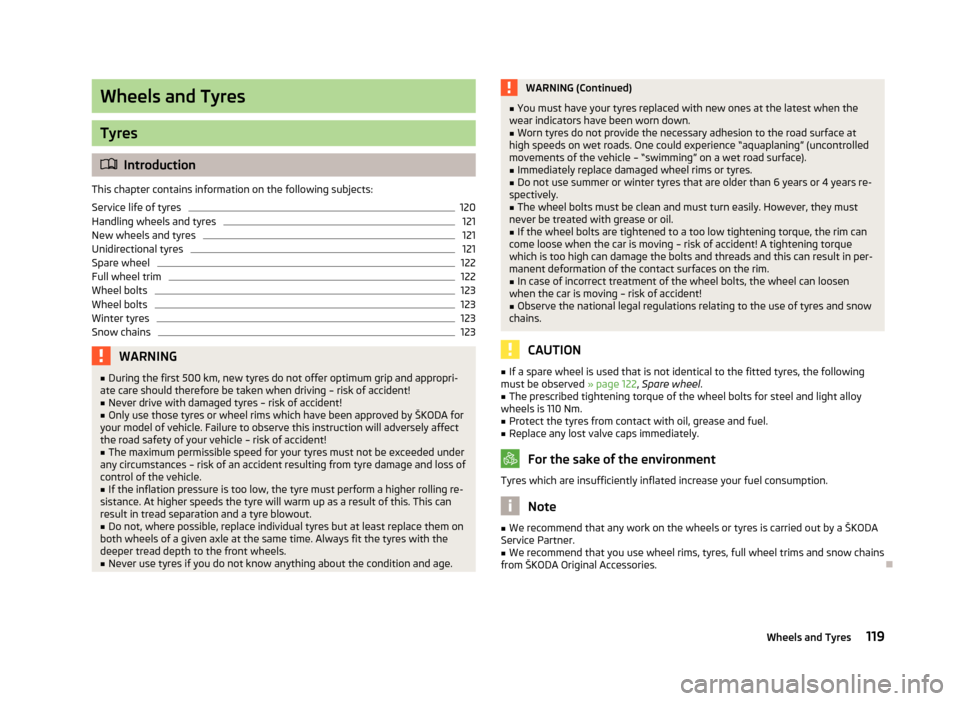
Wheels and Tyres
Tyres
ä
Introduction
This chapter contains information on the following subjects:
Service life of tyres 120
Handling wheels and tyres 121
New wheels and tyres 121
Unidirectional tyres 121
Spare wheel 122
Full wheel trim 122
Wheel bolts 123
Wheel bolts 123
Winter tyres 123
Snow chains 123
WARNING
■ During the first 500 km, new tyres do not offer optimum grip and appropri-
ate care should therefore be taken when driving – risk of accident!
■ Never drive with damaged tyres – risk of accident!
■ Only use those tyres or wheel rims which have been approved by ŠKODA for
your model of vehicle. Failure to observe this instruction will adversely affect
the road safety of your vehicle – risk of accident! ■ The maximum permissible speed for your tyres must not be exceeded under
any circumstances – risk of an accident resulting from tyre damage and loss of
control of the vehicle.
■ If the inflation pressure is too low, the tyre must perform a higher rolling re-
sistance. At higher speeds the tyre will warm up as a result of this. This can
result in tread separation and a tyre blowout.
■ Do not, where possible, replace individual tyres but at least replace them on
both wheels of a given axle at the same time. Always fit the tyres with the
deeper tread depth to the front wheels. ■ Never use tyres if you do not know anything about the condition and age. WARNING (Continued)
■ You must have your tyres replaced with new ones at the latest when the
wear indicators have been worn down.
■ Worn tyres do not provide the necessary adhesion to the road surface at
high speeds on wet roads. One could experience
“aquaplaning” (uncontrolled
movements of the vehicle – “swimming” on a wet road surface).
■ Immediately replace damaged wheel rims or tyres.
■ Do not use summer or winter tyres that are older than 6 years or 4 years re-
spectively.
■ The wheel bolts must be clean and must turn easily. However, they must
never be treated with grease or oil.
■ If the wheel bolts are tightened to a too low tightening torque, the rim can
come loose when the car is moving – risk of accident! A tightening torque
which is too high can damage the bolts and threads and this can result in per-
manent deformation of the contact surfaces on the rim.
■ In case of incorrect treatment of the wheel bolts, the wheel can loosen
when the car is moving – risk of accident! ■ Observe the national legal regulations relating to the use of tyres and snow
chains. CAUTION
■ If a spare wheel is used that is not identical to the fitted tyres, the following
must be observed » page 122, Spare wheel.
■ The prescribed tightening torque of the wheel bolts for steel and light alloy
wheels is 110
Nm.
■ Protect the tyres from contact with oil, grease and fuel.
■ Replace any lost valve caps immediately. For the sake of the environment
Tyres which are insufficiently inflated increase your fuel consumption. Note
■ We recommend that any work on the wheels or tyres is carried out by a
ŠKODA
Service Partner. ■ We recommend that you use wheel rims, tyres, full wheel trims and snow chains
from
ŠKODA Original Accessories. Ð
119
Wheels and Tyres
Page 130 of 157

WARNING
■ The factory-supplied lifting jack is only intended for your model of vehicle.
Under no circumstances attempt to lift heavier vehicles or other loads – risk of
injury!
■ Ensure that the vehicle tool kit is safely secured in the luggage compart-
ment. Note
Ensure that the box is always secured with the strap. ÐChanging a wheel
ä
Introduction
This chapter contains information on the following subjects:
Preliminary work 128
Changing a wheel 129
Subsequent steps 129
Loosening and tightening wheel bolts 130
Raising the vehicle 131
Securing wheels against theft 131
WARNING
■ If you are in flowing traffic, switch on the hazard warning light system and
set up the warning triangle at the prescribed distance! The national legal re-
quirements must be observed. In this way you are not only protecting yourself
but other road users as well.
■ If the wheel is damaged or in the event of a puncture, park the vehicle as far
away as possible from the flow of traffic. Park on as flat and firm a surface as
possible. ■ If the wheel has to be changed on a slope, first of all block the opposite
wheel with a stone or similar object to prevent the vehicle from unexpectedly
rolling away. WARNING (Continued)
■ If the vehicle is subsequently fitted with tyres which are different to those it
was fitted with at the works, follow these guidelines » page 121, New wheels
and tyres.
■ Always raise the vehicle with the doors closed.
■ Never position any body parts, such as arms or legs under the vehicle, while
the vehicle is raised with a lifting jack. ■ Secure the base plate of the lifting jack with suitable means to prevent pos-
sible moving. A soft and slippery ground under the base plate may move the
lifting jack, causing the vehicle to fall down. It is therefore always necessary to
place the lifting jack on a solid surface or use a wide and stable base. Use a
non-slip base (e.g. a rubber foot mat) if the surface is smooth, such as cobbled
stones, tiled floor, etc.
■ Never start the engine with the vehicle sitting on the raised jack – danger of
suffering injury.
■ Only attach the lifting jack to the attachment points provided for this pur-
pose. CAUTION
■ The prescribed tightening torque of the wheel bolts for steel and light alloy
wheels is 120
Nm.
■ If the anti-theft wheel bolt is fastened too tightly, it can cause damage to the
anti-theft wheel bolt and adapter. Note
■ The anti-theft wheel bolt set and adapter can be purchased from a
ŠKODA Serv-
ice Partner. ■ The national legal requirements must be observed when changing a wheel. Ð Preliminary work
First read and observe the introductory information and safety warn-
ings on page 128.
The following steps must be carried out before actually changing the wheel:
›
In the event of a puncture, park the vehicle as far away as possible from the
flow of traffic. The place you choose should be level. £
ä
128 Do-it-yourself
Page 134 of 157
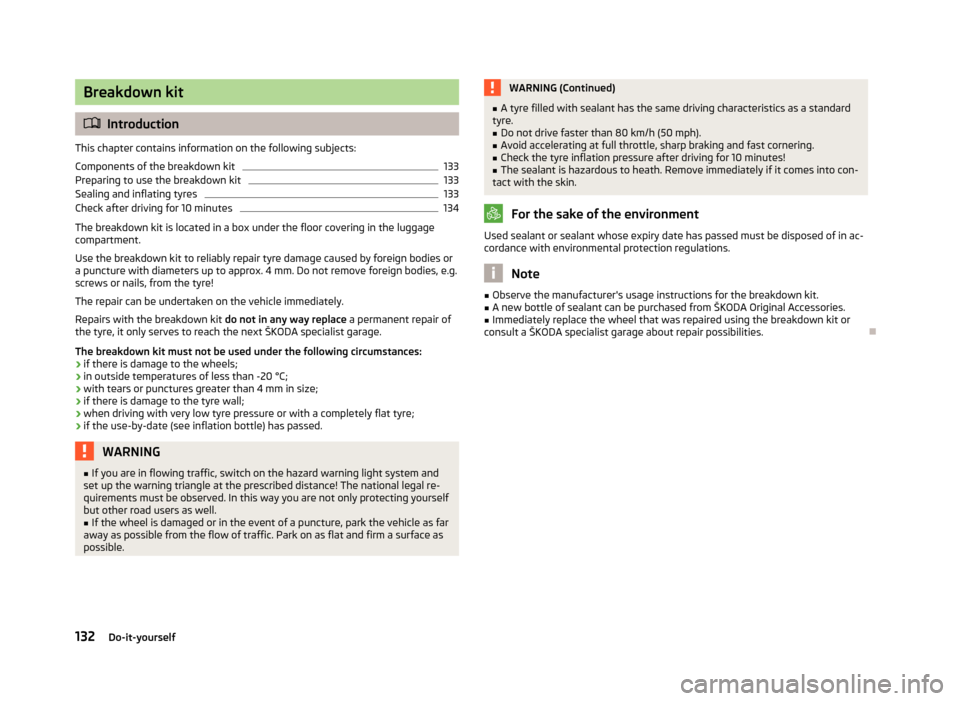
Breakdown kit
ä
Introduction
This chapter contains information on the following subjects:
Components of the breakdown kit 133
Preparing to use the breakdown kit 133
Sealing and inflating tyres 133
Check after driving for 10 minutes 134
The breakdown kit is located in a box under the floor covering in the luggage
compartment.
Use the breakdown kit to reliably repair tyre damage caused by foreign bodies or
a puncture with diameters up to approx. 4
mm. Do not remove foreign bodies, e.g.
screws or nails, from the tyre!
The repair can be undertaken on the vehicle immediately.
Repairs with the breakdown kit do not in any way replace a permanent repair of
the tyre, it only serves to reach the next ŠKODA specialist garage.
The breakdown kit must not be used under the following circumstances:
› if there is damage to the wheels;
› in outside temperatures of less than -20 °C;
› with tears or punctures greater than 4 mm in size;
› if there is damage to the tyre wall;
› when driving with very low tyre pressure or with a completely flat tyre;
› if the use-by-date (see inflation bottle) has passed. WARNING
■ If you are in flowing traffic, switch on the hazard warning light system and
set up the warning triangle at the prescribed distance! The national legal re-
quirements must be observed. In this way you are not only protecting yourself
but other road users as well.
■ If the wheel is damaged or in the event of a puncture, park the vehicle as far
away as possible from the flow of traffic. Park on as flat and firm a surface as
possible. WARNING (Continued)
■ A tyre filled with sealant has the same driving characteristics as a standard
tyre.
■ Do not drive faster than 80 km/h (50 mph).
■ Avoid accelerating at full throttle, sharp braking and fast cornering.
■ Check the tyre inflation pressure after driving for 10 minutes!
■ The sealant is hazardous to heath. Remove immediately if it comes into con-
tact with the skin. For the sake of the environment
Used sealant or sealant whose expiry date has passed must be disposed of in ac-
cordance with environmental protection regulations. Note
■ Observe the manufacturer's usage instructions for the breakdown kit.
■ A new bottle of sealant can be purchased from ŠKODA Original Accessories.
■ Immediately replace the wheel that was repaired using the breakdown kit or
consult a
ŠKODA specialist garage about repair possibilities. Ð
132 Do-it-yourself
Page 140 of 157
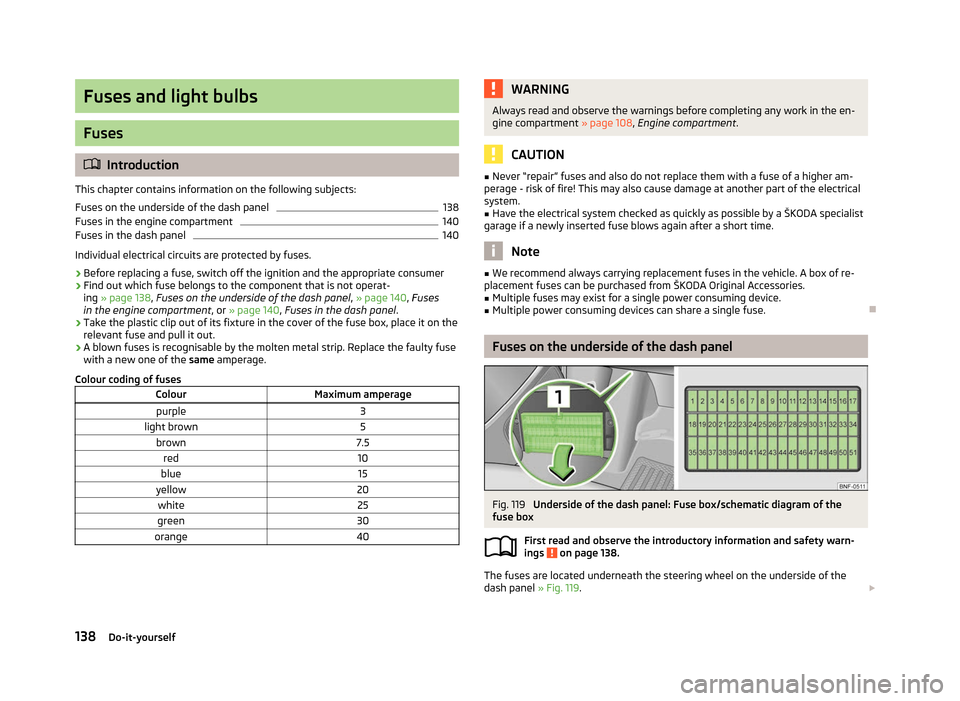
Fuses and light bulbs
Fuses
ä
Introduction
This chapter contains information on the following subjects:
Fuses on the underside of the dash panel 138
Fuses in the engine compartment 140
Fuses in the dash panel 140
Individual electrical circuits are protected by fuses.
› Before replacing a fuse, switch off the ignition and the appropriate consumer
› Find out which fuse belongs to the component that is not operat-
ing » page 138, Fuses on the underside of the dash panel , » page 140, Fuses
in the engine compartment , or »
page 140, Fuses in the dash panel .
› Take the plastic clip out of its fixture in the cover of the fuse box, place it on the
relevant fuse and pull it out.
› A blown fuses is recognisable by the molten metal strip. Replace the faulty fuse
with a new one of the
same amperage.
Colour coding of fuses Colour Maximum amperage
purple 3
light brown 5
brown 7.5
red 10
blue 15
yellow 20
white 25
green 30
orange 40 WARNING
Always read and observe the warnings before completing any work in the en-
gine compartment » page 108, Engine compartment . CAUTION
■ Never “repair” fuses and also do not replace them with a fuse of a higher am-
perage - risk of fire! This may also cause damage at another part of the electrical
system.
■ Have the electrical system checked as quickly as possible by a ŠKODA specialist
garage if a newly inserted fuse blows again after a short time. Note
■ We recommend always carrying replacement fuses in the vehicle. A box of re-
placement fuses can be purchased from
ŠKODA Original Accessories.
■ Multiple fuses may exist for a single power consuming device.
■ Multiple power consuming devices can share a single fuse. Ð Fuses on the underside of the dash panel
Fig. 119
Underside of the dash panel: Fuse box/schematic diagram of the
fuse box
First read and observe the introductory information and safety warn-
ings on page 138.
The fuses are located underneath the steering wheel on the underside of the
dash panel » Fig. 119. £
ä
138 Do-it-yourself
Page 143 of 157

No. Power consumer
11 Starter
12 DC-DC voltage converter Ð
Bulbs
ä
Introduction
This chapter contains information on the following subjects:
Headlights 141
Changing the light bulb for side repeater turn signal lights 142
Changing light bulbs for fog lights 142
Changing the bulb for the licence plate light 143
Tail lamp assembly 143
Some manual skills are required to change a bulb. For this reason, if uncertain, we
recommend that bulbs are replaced by a ŠKODA specialist garage or other expert
help is sought.
› Switch off the ignition and all of the lights before replacing a bulb.
› Faulty bulbs must only be replaced with the same type of bulbs. The designa-
tion is located on the light socket or the glass bulb.
› A stowage compartment for replacement bulbs is located in a plastic box in the
spare wheel or underneath the floor covering in the luggage compartment. WARNING
■ Accidents can be caused if the road in front of the vehicle is not sufficiently
illuminated and the vehicle cannot or can only be seen with difficulty by other
road users.
■ Always read and observe the warnings before completing any work in the
engine compartment » page 108, Engine compartment .
■ The H4 bulb is under pressure and may explode during a lamp replacement -
risk of injury! We therefore recommended wearing gloves and safety glasses
when changing a bulb. CAUTION
■ Do not take hold of the glass bulb with naked fingers (even the smallest
amount of dirt reduces the working life of the light bulb). Use a clean cloth, nap-
kin, or similar. ■ When removing and installing the number plate light and tail light make sure
that the paintwork of the vehicle and the tail light are not damaged. Note
■ This Owner's Manual only describes the replacement of bulbs where it is possi-
ble to replace the bulbs on your own without any complications arising. Other
light bulbs should be changed by a
ŠKODA specialist garage.
■ We recommend that a box of replacement bulbs be always carried in the vehi-
cle. Replacement bulbs can be purchased from
ŠKODAOriginal Accessories.
■ We recommend that the headlight settings are checked by a ŠKODA specialist
garage after replacing a bulb in the main or low beam.
■ LED diodes should be changed by a specialist ŠKODA garage. Ð Headlights
Fig. 122
Left headlight - engine compartment: Arrangement/lamp removal
First read and observe the introductory information and safety warn-
ings on page 141.
Open the bonnet before replacing the bulb in the front headlight
» page 110,
Opening and closing the bonnet .
Bulb arrangement in the front headlight A
- Front turn signal light
» Fig. 122 £
ä
141
Fuses and light bulbs
Page 150 of 157

Index
A
ABS 61
Warning light 17
Accessories 125
Adjusting Exterior mirror 36
Interior mirror 35
Adjusting seats 75
Adjustment Seat 38
Aerial 98
Airbag Deployment 82
Front airbag 83
Side airbag Head-Thorax 84
Switching off 85
System description 82
Air conditioning system 53
Recirculated air mode 55
Antilock brake system 61
Ash tray 45
Assistance systems ESC 60
Assist systems ABS 17, 61
City Safe Drive 66
Cruise control systems (CCS) 63
EDL 61
ESC 17
Parking aid 62
START/STOP 65
TCS 61
Traction Control System (TCS) 17
Visual parking system 63Automatic gearbox 69
Dynamic shift programme 71
Information for driving 69
Kickdown 71
Operational faults 71
Parking 69
Selector lever positions 70
Starting off 69
Stopping 69
Tiptronic 70
Automatic load deactivation 118
Avoiding damage to your vehicle 95
B
Before setting off 74
Belts 78
Belt tensioners 80
Bonnet Closing 110
Opening 110
Brake assist 60
Brake booster 60
Brake fluid Checking 113
Brakes Handbrake 60
Running in 91
Warning light 15
Braking Brake fluid 113
Breakdown kit 132
Bulbs Replacing 141
Button in the driver's door Electrical power windows 26
C
Car computer see Multifunction display 11Car jack 127
Carrier 44
Catalytic converter 91
Central locking button 23
Central locking system 21
lock 22
unlock 22
Changes 125
Changing Engine oil 112
Wheel 128
Charging a vehicle battery 117
Checking Battery electrolyte level 116
Brake fluid 113
Coolant level 112
Engine oil 111
Oil level 111
Windscreen washer fluid 114
Children and safety 87
Child safety Side airbag 88
Child safety lock 21
Child seat Classification 88
ISOFIX 89
on the front passenger seat 87
Suitability 89
TOP TETHER 90
Chrome parts refer to Taking care of your vehicle 99
Cigarette lighter 46
City Safe Drive 66
Warning light 19
Cleaning 97
Artificial leather 101
Headlight lenses 100
Material coverings 102
Materials 101
Natural leather 102
148 Index
Page 151 of 157
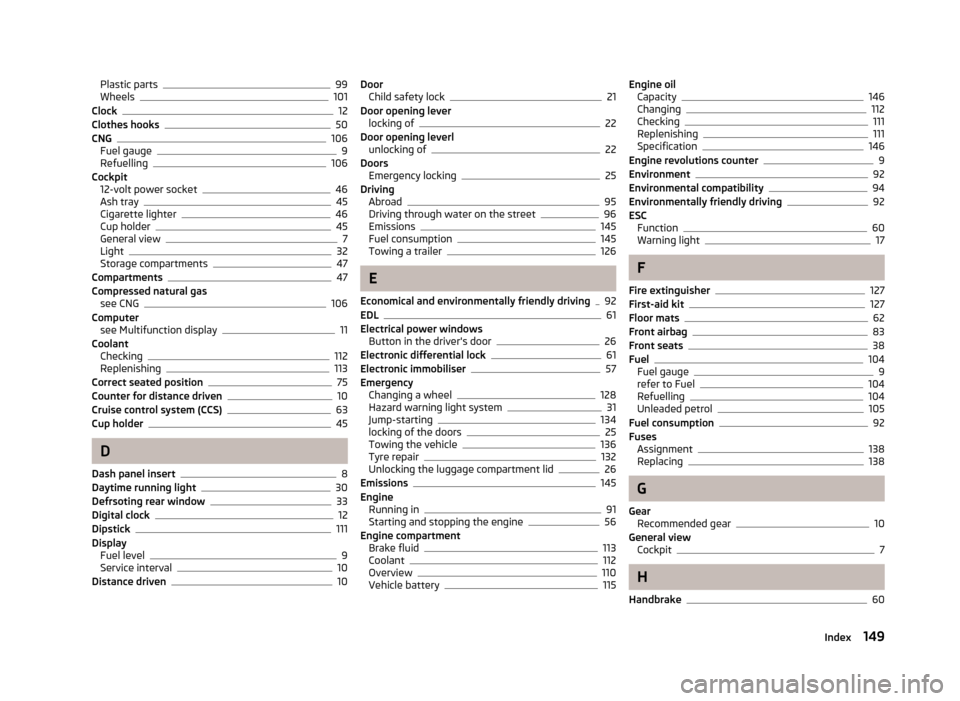
Plastic parts 99
Wheels 101
Clock 12
Clothes hooks 50
CNG 106
Fuel gauge 9
Refuelling 106
Cockpit 12-volt power socket 46
Ash tray 45
Cigarette lighter 46
Cup holder 45
General view 7
Light 32
Storage compartments 47
Compartments 47
Compressed natural gas see CNG 106
Computer see Multifunction display 11
Coolant Checking 112
Replenishing 113
Correct seated position 75
Counter for distance driven 10
Cruise control system (CCS) 63
Cup holder 45
D
Dash panel insert 8
Daytime running light 30
Defrsoting rear window 33
Digital clock 12
Dipstick 111
Display Fuel level 9
Service interval 10
Distance driven 10Door
Child safety lock 21
Door opening lever locking of 22
Door opening leverl unlocking of 22
Doors Emergency locking 25
Driving Abroad 95
Driving through water on the street 96
Emissions 145
Fuel consumption 145
Towing a trailer 126
E
Economical and environmentally friendly driving 92
EDL 61
Electrical power windows Button in the driver's door 26
Electronic differential lock 61
Electronic immobiliser 57
Emergency Changing a wheel 128
Hazard warning light system 31
Jump-starting 134
locking of the doors 25
Towing the vehicle 136
Tyre repair 132
Unlocking the luggage compartment lid 26
Emissions 145
Engine Running in 91
Starting and stopping the engine 56
Engine compartment Brake fluid 113
Coolant 112
Overview 110
Vehicle battery 115Engine oil
Capacity 146
Changing 112
Checking 111
Replenishing 111
Specification 146
Engine revolutions counter 9
Environment 92
Environmental compatibility 94
Environmentally friendly driving 92
ESC Function 60
Warning light 17
F
Fire extinguisher 127
First-aid kit 127
Floor mats 62
Front airbag 83
Front seats 38
Fuel 104
Fuel gauge 9
refer to Fuel 104
Refuelling 104
Unleaded petrol 105
Fuel consumption 92
Fuses Assignment 138
Replacing 138
G
Gear Recommended gear 10
General view Cockpit 7
H
Handbrake 60
149
Index
Page 152 of 157

Head-Thorax 84
Headlights Driving abroad 95
Head restraint 40
Heating 52
Exterior mirror 36
Rear window 33
recommended settings 53
Seats 39
Heating rear window 33
Horn 7
I
Ignition 58
Ignition lock 58
Immobiliser 57
Instrument cluster 8
ISOFIX 89
J
Jacking points Raise vehicle 131
Jump-starting 134
L
Lever Main beam 31
Turn signal 31
Light Cockpit 32
Daytime running light 30
Fog lights 30
Hazard warning light system 31
Headlight beam adjustment 30
Headlight flasher 32
Low beam 29
Main beam 31
Parking light 29, 30Rear fog light 30
Replacing bulbs 141
Turn signal 31
Lights Switching lights on and off 29
Loads 145
Lock Central locking system 22
Locking Door opening lever 22
Emergency locking 25
Remote control 24
Locking and unlocking from the inside 23
luggage compartment see luggage compartment lid 25
Luggage compartment Bag hooks 42
cover 43
Emergency unlocking 26
Fixing nets 43
Lashing eyes 42
Unlocking the luggage compartment lid 26
Luggage compartment lid 25
M
Mirror Additional interior mirror 36
Exterior 36
Vanity 33
Mobile phone 72
Multifunction display Functions 11
Memory 11
Operation 12
O
Oil refer to Engine oil 111Onboard computer
see Multifunction display 11
Operation in winter De-icing windows 100
Vehicle battery 117
Outside temperature 12
Overview Engine compartment 110
Warning lights 14
P
Paint see Paint damage 99
Paint damage 99
Parking Parking aid 62
Visual parking system 63
Parking ticket holder 50
Passive Safety 74
Periodic wiping 34
Petrol refer to Fuel 105
Polishing the paintwork refer to Taking care of your vehicle 99
Power steering 57
Power windows Button in the driver's door 27
Preservation refer to Taking care of your vehicle 99
R
Radiator fan 113
Radio reception Operating problem 100
Raise vehicle 131
Rear mirror Exterior 36
Interior 35
150 Index
Page 153 of 157
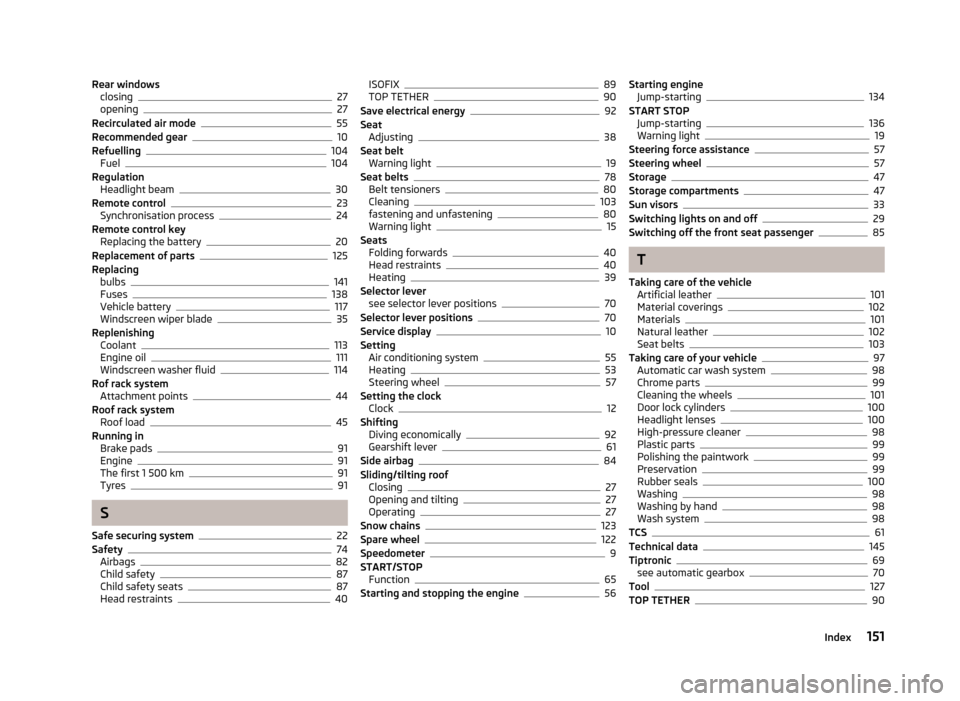
Rear windows
closing 27
opening 27
Recirculated air mode 55
Recommended gear 10
Refuelling 104
Fuel 104
Regulation Headlight beam 30
Remote control 23
Synchronisation process 24
Remote control key Replacing the battery 20
Replacement of parts 125
Replacing bulbs 141
Fuses 138
Vehicle battery 117
Windscreen wiper blade 35
Replenishing Coolant 113
Engine oil 111
Windscreen washer fluid 114
Rof rack system Attachment points 44
Roof rack system Roof load 45
Running in Brake pads 91
Engine 91
The first 1 500 km 91
Tyres 91
S
Safe securing system 22
Safety 74
Airbags 82
Child safety 87
Child safety seats 87
Head restraints 40ISOFIX 89
TOP TETHER 90
Save electrical energy 92
Seat Adjusting 38
Seat belt Warning light 19
Seat belts 78
Belt tensioners 80
Cleaning 103
fastening and unfastening 80
Warning light 15
Seats Folding forwards 40
Head restraints 40
Heating 39
Selector lever see selector lever positions 70
Selector lever positions 70
Service display 10
Setting Air conditioning system 55
Heating 53
Steering wheel 57
Setting the clock Clock 12
Shifting Diving economically 92
Gearshift lever 61
Side airbag 84
Sliding/tilting roof Closing 27
Opening and tilting 27
Operating 27
Snow chains 123
Spare wheel 122
Speedometer 9
START/STOP Function 65
Starting and stopping the engine 56Starting engine
Jump-starting 134
START STOP Jump-starting 136
Warning light 19
Steering force assistance 57
Steering wheel 57
Storage 47
Storage compartments 47
Sun visors 33
Switching lights on and off 29
Switching off the front seat passenger 85
T
Taking care of the vehicle Artificial leather 101
Material coverings 102
Materials 101
Natural leather 102
Seat belts 103
Taking care of your vehicle 97
Automatic car wash system 98
Chrome parts 99
Cleaning the wheels 101
Door lock cylinders 100
Headlight lenses 100
High-pressure cleaner 98
Plastic parts 99
Polishing the paintwork 99
Preservation 99
Rubber seals 100
Washing 98
Washing by hand 98
Wash system 98
TCS 61
Technical data 145
Tiptronic 69
see automatic gearbox 70
Tool 127
TOP TETHER 90
151
Index